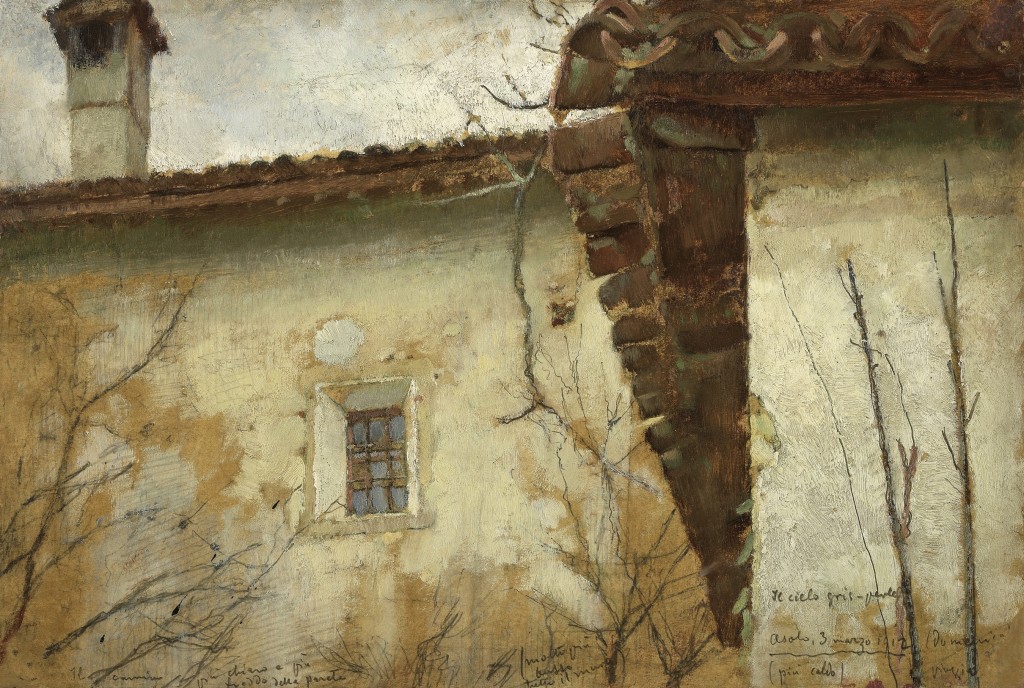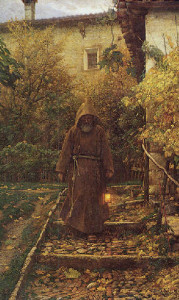Luigi Nono (Fusina near Venice 1850 - 1918 Venice)
Sketch for the Painting titled ‘1 November’, Asolo 1912
Oil on paper mounted on cardboard, 20.8 x 31 cm
Dated Asolo, 3 marzo 1912 and with precise colour annotations by the artist Il cielo gris-verde / (domenica di / pioggia) / (più caldo) / Il camino / più chiaro e più / freddo della parete / (molto più / basso / tutto il muro)[1]. Bearing a label on the verso Galleria d’Arte Eleuteri / Roma / Luigi Nono ‘La finestra romita’ and the handwritten inscription in black ink Dichiaro che questo „studio“ fu dipinto / da mio Padre, Luigi Nono. / [...] Nono / 6 Dicembre 1940.[2]
Provenance:
Galleria d’Arte Eleuteri, Rome
Private collection, Italy
Literature:
Paolo Serafini, Il pittore Luigi Nono (1850-1918): catalogo ragionato dei dipinti e dei disegni, cat. raisonné, Turin 2006, II, p.192, no. 621 (titled “Studio per I Novembre”)
Luigi Nono made the first of many study trips to Asolo[3] in 1907. It was here that he executed on 20 February 1912 the first preparatory drawing for the painting titled 1 November.[4] The present oil sketch is clearly a plein-air study with the striking immediacy of a impression captured before the motif. Its spontaneity actively involves the viewer in the creative process. It depicts an L-shaped building in sharply foreshortened perspective – a brief moment of observed reality with the informal character of a snapshot. Nono has used a sharpened brush handle to scratch date and place of execution into the wet paint. He has also added precise colour annotations to define the tonal nuances to be used in working up a final version of the composition in the studio – in this case the painting of the same year titled 1 November[5] (Fig. 1). He exhibited it at the 10th Biennale in Venice in 1912, where it found a buyer.[6]
The three paintings titled 1 November, Collecting Leaves (Serafini 655) and Monks at a Well (Serafini 707) belong to a group of compositions with the seclusion of monastic life as their main theme.[7]
Luigi Nono – the grandfather of the eponymous composer – was born in Fusina near Venice. He grew up in Sacile, a town in the northern Veneto. He enrolled at the Accademia di Belle Arti in Venice and studied from 1865 to 1871 under Pompeo Molmenti (1819-94). At the Academy his work came under the influence of Giacomo Favretto (1849-87), a leading exponent of the Venetian Realist tradition. In 1873 Nono exhibited three paintings at the Accademia di Brera in Milan. By this time he had moved away from academic tradition and his style was more closely related to that of Favretto.
Nono travelled to Florence, Rome and Naples in 1876. In 1878 he was in Vienna. On his visit to Paris in the same year he was greatly impressed by the artists of the Barbizon School. When his father died in 1879 Nono moved the focus of his activities and interests to Venice. In 1888 he made his debut at the ‘Esposizione Nazionale Artistica’ in the Giardini. This exhibition was the forerunner of the Venice Biennale. It was originally launched in 1895 under the title ‘I Esposizione Internazionale d’Arte della Città di Venezia’ [First International Art Exhibition of the City of Venice].[8] Nono was a regular contributor to the Biennale exhibitions. His work was also shown in Berlin, Munich and St. Petersburg. He was appointed a professor at the Accademia di Belle Arti in Venice in 1899. He is regarded as one of the most popular and sought-after Venetian artists of the nineteenth century.[9] He, together with Favretto and Guglielmo Ciardi (1842-1917), had a formative influence on Realist developments in Venice at the turn of the century.
Nono’s work displays a preference for subjects critical of social conditions and motifs that focus on peasant and working-class life. The painting titled Returning from the Fields, executed in 1873, is a good example. His important painting titled Refugium peccatorum [Refuge of Sinners] won the Gold Medal at the Munich International Exhibition in 1883 and saw him advance to the forefront of socio-critical Realism in Italy.[10]
[1] Translated, this reads: The sky grey-green / (rainy / Sunday) / (warmer) / the chimney / lighter and / colder than the wall / (the whole wall far deeper). The inscription on the verso by Mario Nono reads: ‘Luigi Nono “The window of the hermitage”. I declare that this “study” was painted by my father, Luigi Nono. […] Nono. 6 December 1940.’ [2] The signature ‘Nono’ is that of the artist’s son, Mario Nono (1890-1975). He was an engineer by profession. See Enzo Restagno, Nono, Turin 1987, p.5. [3] Records show that Nono visited Asolo in 1907, 1909 and 1911-13. See Pavanello, La pittura nel Veneto op. cit., p.777. In a letter to his wife Rina, dated 26 October 1911, Nono states that he has accommodation in the St. Anna Convent in Asolo and is planning to return to Venice on 11 November. He planned a further visit to Asolo in the following year. See Serafini op. cit., I, p.58. [4] The first drawing is a vertical-format pencil drawing (Serafini 616) depicting the entire facade and the leafless tree. Further studies and drawings relating to the facade of St. Anna were to follow: Study for ‘1 November’: colour annotations relating to the window and the crack in the wall (Serafini 617).- Study for ‘1 November’: colour annotations relating to the chimney (Serafini 620). [5] 1 November, 1912, oil on canvas, 122.5 x 75 cm (Serafini 631). Private collection, Sacile. Serafini, op. cit., I, plate XCVI; II, repr. p.194.
Later versions of the painting also exist:
- 1 November, 1915, oil on canvas, 85 x 44.5 cm (Serafini 700). Private collection, Bologna. See Serafini op. cit., II, repr. p.218.
- 1 November, undated, oil on canvas, 23 x 13.6 cm (Serafini 720). Private collection, Belluno. See Serafini op. cit., II, repr. p.225.


